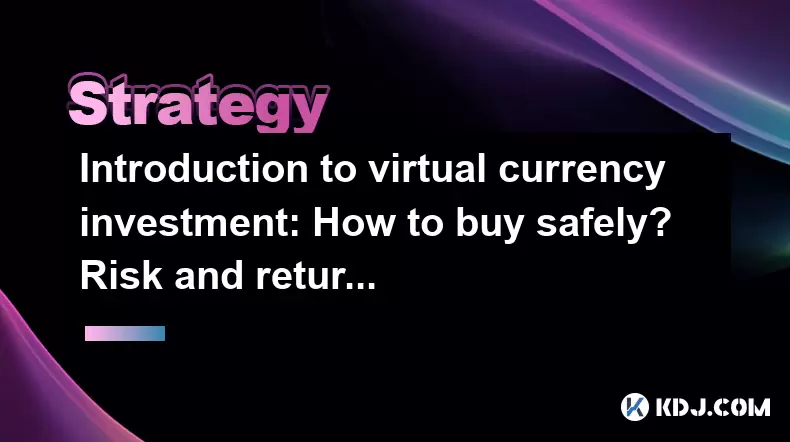-
 bitcoin
bitcoin $122659.385674 USD
0.52% -
 ethereum
ethereum $4484.113342 USD
-0.09% -
 bnb
bnb $1304.229256 USD
-0.85% -
 tether
tether $1.000204 USD
-0.03% -
 xrp
xrp $2.860636 USD
-0.51% -
 solana
solana $227.288799 USD
2.36% -
 usd-coin
usd-coin $0.999805 USD
0.01% -
 dogecoin
dogecoin $0.252837 USD
1.18% -
 tron
tron $0.341149 USD
1.12% -
 cardano
cardano $0.830507 USD
0.33% -
 hyperliquid
hyperliquid $45.792319 USD
0.04% -
 chainlink
chainlink $22.422164 USD
1.55% -
 ethena-usde
ethena-usde $1.000283 USD
0.01% -
 sui
sui $3.511389 USD
0.83% -
 stellar
stellar $0.385276 USD
-0.44%
Introduction to virtual currency investment: How to buy safely? Risk and return analysis
To safely invest in volatile virtual currencies like Bitcoin, use reputable exchanges, secure your account with 2FA, and transfer assets to a hardware wallet for long-term storage.
May 26, 2025 at 06:43 pm

Virtual currency, often referred to as cryptocurrency, has become a significant topic in the investment world. Whether you are a seasoned investor or a newcomer, understanding how to safely navigate this volatile market is crucial. This article will guide you through the process of buying virtual currency safely, and provide a detailed analysis of the risks and potential returns associated with these investments.
Understanding Virtual Currency
Virtual currency encompasses a range of digital or virtual currencies that use cryptography for security. The most well-known virtual currency is Bitcoin, but there are thousands of others, including Ethereum, Litecoin, and Ripple. These currencies operate on decentralized networks called blockchains, which are essentially public ledgers that record all transactions.
Before investing, it's essential to understand the basic principles of how virtual currencies work. They are not backed by any central authority or government, which means their value is determined purely by supply and demand in the market. This can lead to significant price volatility, which is both a risk and an opportunity for investors.
How to Buy Virtual Currency Safely
Buying virtual currency safely involves several steps, from choosing a reputable exchange to securing your investments. Here is a detailed guide on how to proceed:
Choose a Reputable Exchange: The first step in buying virtual currency is to select a reputable exchange. Popular exchanges include Coinbase, Binance, and Kraken. Research the exchange's reputation, fees, and security measures before signing up.
Create an Account: Once you have chosen an exchange, you will need to create an account. This typically involves providing personal information and verifying your identity, a process known as Know Your Customer (KYC) verification.
Secure Your Account: Security is paramount when dealing with virtual currencies. Use strong, unique passwords for your exchange account and enable two-factor authentication (2FA) to add an extra layer of security.
Deposit Funds: After setting up your account, you will need to deposit funds into the exchange. Most exchanges accept bank transfers, credit/debit cards, and sometimes other cryptocurrencies.
Buy Virtual Currency: With funds in your account, you can now buy virtual currency. Most exchanges offer a user-friendly interface where you can select the cryptocurrency you want to buy and the amount. Double-check the details before confirming the purchase.
Transfer to a Wallet: For long-term storage, it's advisable to transfer your virtual currency to a secure wallet. There are various types of wallets, including hardware wallets, software wallets, and paper wallets. Hardware wallets, like Ledger and Trezor, are considered the most secure option.
Risks of Virtual Currency Investment
Investing in virtual currency comes with a range of risks that investors should be aware of:
Volatility: Virtual currencies are known for their extreme volatility. Prices can fluctuate wildly within short periods, which can lead to significant gains or losses.
Regulatory Risk: The regulatory environment for virtual currencies is still evolving. Changes in regulations can impact the value and legality of these investments.
Security Risk: Virtual currencies are attractive targets for hackers. Exchanges and wallets can be vulnerable to cyber attacks, leading to the loss of funds.
Liquidity Risk: Some virtual currencies have low liquidity, making it difficult to buy or sell large amounts without affecting the market price.
Potential Returns of Virtual Currency Investment
Despite the risks, virtual currency investments can offer substantial returns. Here are some factors to consider:
High Growth Potential: Some virtual currencies have seen exponential growth. Early investors in Bitcoin, for example, have seen returns of thousands of percent.
Diversification: Adding virtual currencies to your investment portfolio can provide diversification, potentially reducing overall risk.
Innovation: Many virtual currencies are built on innovative technologies like blockchain, which have the potential to revolutionize various industries.
Analyzing Risk vs. Return
When considering an investment in virtual currency, it's important to analyze the risk versus the potential return. Here are some key points to keep in mind:
Risk Tolerance: Assess your risk tolerance before investing. If you are risk-averse, you may want to allocate a smaller portion of your portfolio to virtual currencies.
Research: Conduct thorough research on the virtual currency you are considering. Look at the project's whitepaper, team, and development progress.
Diversification: Consider diversifying your virtual currency investments across different assets to spread risk.
Long-Term vs. Short-Term: Decide whether you are investing for the long term or short term. Long-term investors may be more willing to weather volatility, while short-term traders need to be prepared for rapid price changes.
Practical Steps to Manage Risk
Managing risk in virtual currency investments requires a strategic approach. Here are some practical steps you can take:
Set Stop-Loss Orders: If you are trading virtual currencies, consider using stop-loss orders to limit potential losses. A stop-loss order automatically sells your holdings if the price drops to a certain level.
Regularly Review Your Portfolio: Keep a close eye on your investments and the market. Regularly review your portfolio to ensure it aligns with your risk tolerance and investment goals.
Stay Informed: Stay up-to-date with news and developments in the virtual currency space. Regulatory changes, technological advancements, and market trends can all impact your investments.
Use Cold Storage: For long-term holdings, use cold storage solutions like hardware wallets to protect your virtual currencies from online threats.
Frequently Asked Questions
Q: What is the best virtual currency to invest in?A: There is no definitive 'best' virtual currency to invest in, as it depends on your investment goals, risk tolerance, and market conditions. Bitcoin and Ethereum are often considered more stable options, while smaller altcoins may offer higher potential returns but also come with increased risk.
Q: How much should I invest in virtual currency?A: The amount you should invest in virtual currency depends on your overall financial situation and risk tolerance. A common recommendation is to allocate only a small percentage of your portfolio to high-risk assets like virtual currencies, typically no more than 5-10%.
Q: Can I lose all my money investing in virtual currency?A: Yes, it is possible to lose all your money investing in virtual currency due to the high volatility and risks involved. It's crucial to invest only what you can afford to lose and to use risk management strategies.
Q: Is it better to buy and hold virtual currency or trade actively?A: Whether to buy and hold or trade actively depends on your investment strategy and risk tolerance. Buy and hold (HODL) strategies can be less stressful and potentially benefit from long-term growth, while active trading can offer quicker returns but requires more time and skill.
Disclaimer:info@kdj.com
The information provided is not trading advice. kdj.com does not assume any responsibility for any investments made based on the information provided in this article. Cryptocurrencies are highly volatile and it is highly recommended that you invest with caution after thorough research!
If you believe that the content used on this website infringes your copyright, please contact us immediately (info@kdj.com) and we will delete it promptly.
- Cardano, XRP, and DeFi Integration: A Bombshell Development?
- 2025-10-10 08:25:17
- Crypto Presales: LivLive & the Rush for Early Entry in 2025
- 2025-10-10 08:25:17
- Bitcoin Cash, Trust, and Prime Brokers: A New Era of Transparency?
- 2025-10-10 06:45:16
- Ripple's Stablecoin Expansion: Bahrain, Web3, and RLUSD's Big Push
- 2025-10-10 06:25:13
- Memecoin Trader's Success: Riding the Crypto Wave Like a Pro
- 2025-10-10 06:25:13
- Crypto Presales & Massive Gains: Is AlphaPepe the Next Big Meme Coin?
- 2025-10-10 08:30:13
Related knowledge

Practical parameter settings for a Bitcoin multi-timeframe moving average system
Sep 18,2025 at 10:54pm
Optimizing Timeframe Combinations for Bitcoin Trading1. Selecting appropriate timeframes is crucial when building a multi-timeframe moving average sys...

How can I filter out false breakouts in Dogecoin high-frequency trading?
Sep 22,2025 at 01:00am
Understanding False Breakouts in Dogecoin Trading1. A false breakout occurs when Dogecoin's price appears to move beyond a defined support or resistan...

Techniques for identifying tops and bottoms in the Bitcoin on-chain NVT model
Sep 20,2025 at 07:54pm
Understanding the NVT Model in Bitcoin Analysis1. The Network Value to Transactions (NVT) ratio is often described as the 'P/E ratio' of the cryptocur...

What does the surge in open interest in Bitcoincoin futures mean?
Sep 20,2025 at 11:18pm
Understanding the Surge in Dogecoin Futures Open Interest1. A surge in open interest within Dogecoin futures indicates a growing number of active cont...

How can I use the Ethereum USDT premium to gauge market sentiment?
Sep 18,2025 at 11:55pm
Understanding the Ethereum USDT Premium1. The Ethereum USDT premium refers to the price difference between USDT (Tether) traded on Ethereum-based plat...

What should I do if Ethereum staking yields decline?
Sep 20,2025 at 06:18am
Understanding the Causes Behind Declining Ethereum Staking Yields1. The Ethereum network transitioned to a proof-of-stake consensus mechanism with the...

Practical parameter settings for a Bitcoin multi-timeframe moving average system
Sep 18,2025 at 10:54pm
Optimizing Timeframe Combinations for Bitcoin Trading1. Selecting appropriate timeframes is crucial when building a multi-timeframe moving average sys...

How can I filter out false breakouts in Dogecoin high-frequency trading?
Sep 22,2025 at 01:00am
Understanding False Breakouts in Dogecoin Trading1. A false breakout occurs when Dogecoin's price appears to move beyond a defined support or resistan...

Techniques for identifying tops and bottoms in the Bitcoin on-chain NVT model
Sep 20,2025 at 07:54pm
Understanding the NVT Model in Bitcoin Analysis1. The Network Value to Transactions (NVT) ratio is often described as the 'P/E ratio' of the cryptocur...

What does the surge in open interest in Bitcoincoin futures mean?
Sep 20,2025 at 11:18pm
Understanding the Surge in Dogecoin Futures Open Interest1. A surge in open interest within Dogecoin futures indicates a growing number of active cont...

How can I use the Ethereum USDT premium to gauge market sentiment?
Sep 18,2025 at 11:55pm
Understanding the Ethereum USDT Premium1. The Ethereum USDT premium refers to the price difference between USDT (Tether) traded on Ethereum-based plat...

What should I do if Ethereum staking yields decline?
Sep 20,2025 at 06:18am
Understanding the Causes Behind Declining Ethereum Staking Yields1. The Ethereum network transitioned to a proof-of-stake consensus mechanism with the...
See all articles


























![🚨IS VECHAIN (VET) A DEAD COIN ?? PRICE ANALYSIS [GET READY NOW] 🚨IS VECHAIN (VET) A DEAD COIN ?? PRICE ANALYSIS [GET READY NOW]](/uploads/2025/10/09/cryptocurrencies-news/videos/vechain-vet-dead-coin-price-analysis-ready/68e7b200b067b_image_500_375.webp)















































